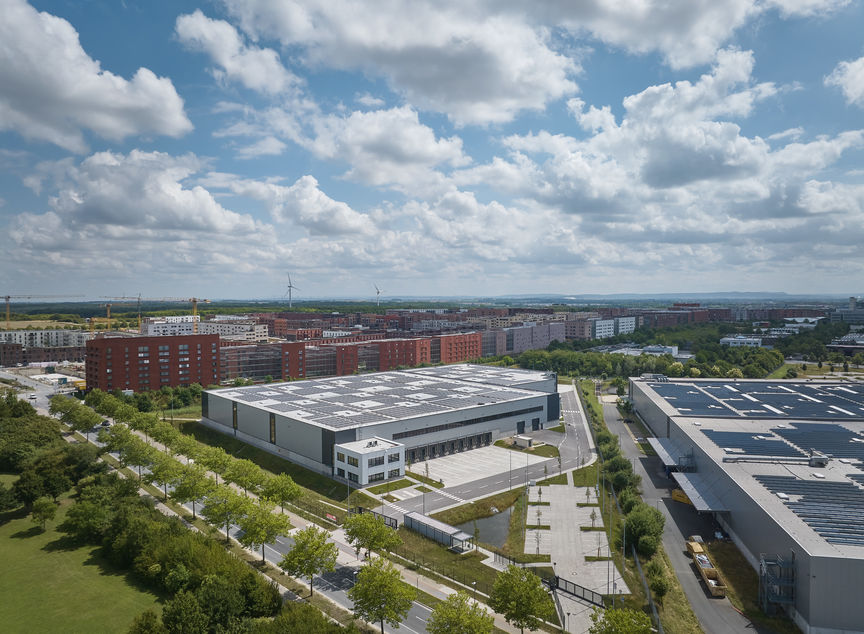Logistics real estate market
In 2024, the regional market for logistics and production properties closed on a weak note with take-up of just over 130,000 sqm. Around 85,000 sqm were taken up in the first half of 2025. This does not yet indicate a clear trend reversal, but take-up appears to be stabilizing with rents rising.
Despite the economic slowdown in the German economy and ongoing uncertainties - for example with regard to international supply chains and customs restrictions - the demand for readily available new logistics space will continue to shape the market in the medium term. Several projects in the Hannover Region are almost complete and will be available to the market in the short term.
Market sentiment and trends
Over the past ten to fifteen years, there has been a sustained increase in demand for logistics and production space in the region. Between 2019 and 2022, annual demand stabilized at around 400,000 sqm.
The significant decline in take-up in 2023 and 2024 is due to various demand and supply-related reasons. Comparably low take-up levels were last recorded in the years 2012 to 2016 (at that time mainly due to a shortage of available space). However, the persistent economic slowdown in the manufacturing sector (also caused by international crises and conflicts as well as the tariff discussions between the USA and the EU) and the associated uncertainties for the logistics industry are likely to be the main reasons for the current weak take-up levels. Another effect that is difficult to grasp in terms of quality and quantity is the so-called grey space: in the current economic environment, contract logistics companies in particular can manage new customer orders in the already rented and in some cases underused space or extend rental agreements instead of changing or expanding their micro-location.
High completion figures despite weak demand
However, the current project developments and completions confirm the fundamental confidence of market players in the Hannover Region as a robust location for logistics and production.
The increased proportion of speculative project developments in recent years should be emphasized, which ensures that modern space can also be rented at short notice. However, due to the general conditions outlined above, there is increased uncertainty with regard to the future project pipeline, which is why individual projects have already been delayed.
Between 2020 and 2024, around 820,000 sqm of warehouse space for logistics and production was completed in the Hannover Region. Projects for around 275,000 sqm of hall space are currently known for the years 2025 to 2027.
Prime rent picks up
The prime rent has risen slightly by 20 cents to EUR 6.60 per sqm, while the average rent has also increased slightly to EUR 5.10 per sqm. Depending on the level of fit-out and location, however, individual properties can also achieve significantly higher rents.
Logistics and production are the strongest asset class on the regional investment market
With a share of almost 50% of the total transaction volume, the logistics and production properties submarket again accounted for the most investments in 2024, up from 75% in the previous year. A good €200 million was transacted in 2024 (down €100 million on 2023). The market is primarily characterized by the sale of large properties as part of portfolio transactions in the logistics sector. Market participants expect the prime yield to rise to 5.2% in 2025.
Market outlook: short-term restraint - increasing demand pressure in the long term
Although there were slight signs of recovery in many German and European logistics real estate markets in the first half of 2025, these still fell short of market participants' expectations.
Nevertheless, two trends in particular are expected to lead to sustained demand for suitable logistics and light industrial space in the long term, even if this does not appear to be clearly recognizable at present:
- Online retail has built up very large space capacities in recent years. It is not currently the strong demand driver. Nevertheless, e-commerce will continue to play a significant role in the demand for space in the logistics real estate market, with online grocery retailing being a segment that has recently experienced strong growth.
- The effect of the relocation (re-shoring and near-shoring) of production facilities to Germany or neighboring European countries has so far been limited. Nevertheless, the energy transition, digitalization, the increasing importance of electromobility in the automotive industry and, more recently, the defence sector are driving restructuring that is fundamentally strengthening demand for logistics and production properties.
In the medium to long term, market participants therefore believe that demand for warehouse space is likely to pick up again and that the high capacity utilization of logistics infrastructures, including in the courier, express and parcel services (CEP) sector, will continue or grow further.
At present, however, the weak economy throughout Germany is overshadowing the fundamentally robust logistics industry and is therefore affecting the specific demand for real estate for logistics and light manufacturing.
The Hannover Region is asserting itself as a strong and resilient location for logistics
From the perspective of market participants, the Hannover Region has established itself as a strong and stable location for logistics and industry for many years. Politics and administration have responded in recent years with a more sustainable land policy: In addition to more economical and targeted land rezoning, municipal players are focusing more on the revitalization of brownfield sites.
Against this backdrop, brownfield developments are also becoming a focus for developers. Municipalities are increasingly focusing on a strategic commercial space policy that also specifically secures previously used land and promotes integrated solutions instead of primarily designating new commercial space on greenfield sites.
Both municipalities and companies will focus more clearly on revitalizing existing sites and consolidating existing commercial locations. It is already becoming apparent today that the growing demand for logistics space, particularly in highly sought-after regions such as Hannover, cannot otherwise be met.
Hannover Region is asserting itself as a strong and resilient location for logistics and production.

